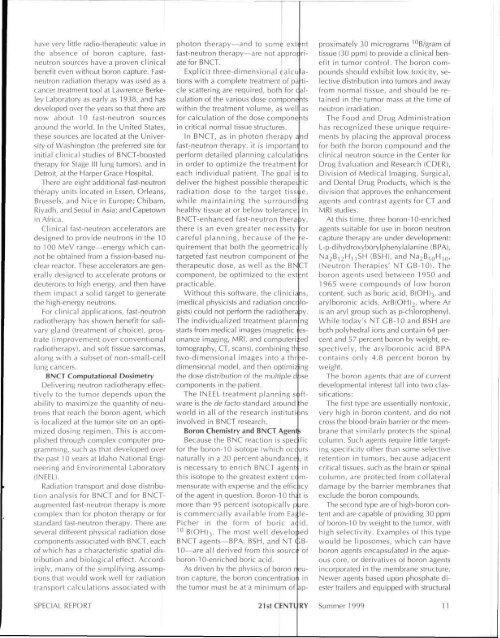Back to the Moon with Nuclear Rockets
Back to the Moon with Nuclear Rockets
Back to the Moon with Nuclear Rockets
- No tags were found...
Create successful ePaper yourself
Turn your PDF publications into a flip-book with our unique Google optimized e-Paper software.
have very little radio-<strong>the</strong>rapeutic value in<strong>the</strong> absence of boron capture, fastneutronsources have a proven clinicalbenefit even <strong>with</strong>out boron capture. Fastneutronradiation <strong>the</strong>rapy was used as acancer treatment <strong>to</strong>ol at Lawrence BerkeleyLabora<strong>to</strong>ry as early as 1938, and hasdeveloped over <strong>the</strong> years so that <strong>the</strong>re arenow about 10 fast-neutron sourcesaround <strong>the</strong> world. In <strong>the</strong> United States,<strong>the</strong>se sources are located at <strong>the</strong> Universityof Washing<strong>to</strong>n (<strong>the</strong> preferred site forinitial clinical studies of BNCT-boosted<strong>the</strong>rapy for Stage III lung tumors), and inDetroit, at <strong>the</strong> Harper Grace Hospital.There are eight additional fast-neutron<strong>the</strong>rapy units located in Essen, Orleans,Brussels, and Nice in Europe; Chibam,Riyadh, and Seoul in Asia; and Cape<strong>to</strong>wnin Africa.Clinical fast-neutron accelera<strong>to</strong>rs aredesigned <strong>to</strong> provide neutrons in <strong>the</strong> 10<strong>to</strong> 100 MeV range—energy which cannotbe obtained from a fission-based nuclearreac<strong>to</strong>r. These accelera<strong>to</strong>rs are generallydesigned <strong>to</strong> accelerate pro<strong>to</strong>ns ordeuterons <strong>to</strong> high energy, and <strong>the</strong>n have<strong>the</strong>m impact a solid target <strong>to</strong> generate<strong>the</strong> high-energy neutrons.For clinical applications, fast-neutronradio<strong>the</strong>rapy has shown benefit for salivarygland (treatment of choice), prostrate(improvement over conventionalradio<strong>the</strong>rapy), and soft tissue sarcomas,along <strong>with</strong> a subset of non-small-celllung cancers,BNCT Computational DosimetryDelivering neutron radio<strong>the</strong>rapy effectively<strong>to</strong> <strong>the</strong> tumor depends upon <strong>the</strong>ability <strong>to</strong> maximize <strong>the</strong> quantity of neutronsthat reach <strong>the</strong> boron agent, whichis localized at <strong>the</strong> tumor site on an optimizeddosing regimen. This is accomplishedthrough complex computer programming,such as that developed over<strong>the</strong> past 10 years at Idaho National Engineeringand Environmental Labora<strong>to</strong>ry(INEEL).Radiation transport and dose distributionanalysis for BNCT and for BNCTaugmentedfast-neutron <strong>the</strong>rapy is morecomplex than for pho<strong>to</strong>n <strong>the</strong>rapy or forstandard fast-neutron <strong>the</strong>rapy. There areseveral different physical radiation dosecomponents associated <strong>with</strong> BNCT, eachof which has a characteristic spatial distributionand biological effect. Accordingly,many of <strong>the</strong> simplifying assumptionsthat would work well for radiationtransport calculations associated <strong>with</strong>pho<strong>to</strong>n <strong>the</strong>rapy—and <strong>to</strong> some extentfast-neutron <strong>the</strong>rapy—are not approj riateforBNCT.Explicit three-dimensional calcu a-tions <strong>with</strong> a complete treatment of pa tidescattering are required, both for calculationof <strong>the</strong> various dose compone its<strong>with</strong>in <strong>the</strong> treatment volume, as well asfor calculation of <strong>the</strong> dose compone itsin critical normal tissue structures.In BNCT, as in pho<strong>to</strong>n <strong>the</strong>rapy andfast-neutron <strong>the</strong>rapy, it is important <strong>to</strong>perform detailed planning calculationsin order <strong>to</strong> optimize <strong>the</strong> treatment oreach individual patient. The goal i< <strong>to</strong>deliver <strong>the</strong> highest possible <strong>the</strong>rapeiticradiation dose <strong>to</strong> <strong>the</strong> target tissue,while maintaining <strong>the</strong> surround nghealthy tissue at or below <strong>to</strong>lerance InBNCT-enhanced fast-neutron <strong>the</strong>ra )y,<strong>the</strong>re is an even greater necessity r orcareful planning, because of <strong>the</strong> e-quirement that both <strong>the</strong> geometric; llytargeted fast neutron component of he<strong>the</strong>rapeutic dose, as well as <strong>the</strong> BNCTcomponent, be optimized <strong>to</strong> <strong>the</strong> extentpracticable.Without this software, <strong>the</strong> clinicians,(medical physicists and radiation once logists)could not perform <strong>the</strong> radio<strong>the</strong>raDy.The individualized treatment plann ngstarts from medical images (magnetic esonanceimaging, MRI, and computerised<strong>to</strong>mography, CT, scans), combining th ;setwo-dimensional images in<strong>to</strong> a thr;edimensionalmodel, and <strong>the</strong>n optimizing<strong>the</strong> dose distribution of <strong>the</strong> multiple d ssecomponents in <strong>the</strong> patient.The INEEL treatment planning softwareis <strong>the</strong> de fac<strong>to</strong> standard around <strong>the</strong>world in all of <strong>the</strong> research institutionsinvolved in BNCT research.Boron Chemistry and BNCT AgentsBecause <strong>the</strong> BNC reaction is spec fiefor <strong>the</strong> boron-10 iso<strong>to</strong>pe (which occursnaturally in a 20 percent abundance , itis necessary <strong>to</strong> enrich BNCT agent: inthis iso<strong>to</strong>pe <strong>to</strong> <strong>the</strong> greatest extent cc m-mensurate <strong>with</strong> expense and <strong>the</strong> effic icyof <strong>the</strong> agent in question. Boron-10 th; t ismore than 95 percent iso<strong>to</strong>pically pjreis commercially available from Eaj le-Picher in <strong>the</strong> form of boric at id,10 B(OH) 3 . The most well developedBNCT agents—BPA, BSH, and NT GB-10—are all derived from this source ofboron-10-enriched boric acid.As driven by <strong>the</strong> physics of boron r eutroncapture, <strong>the</strong> boron concentration in<strong>the</strong> tumor must be at a minimum of approximately30 micrograms 10 B/gram oftissue (30 ppm) <strong>to</strong> provide a clinical benefitin tumor control. The boron compoundsshould exhibit low <strong>to</strong>xicity, selectivedistribution in<strong>to</strong> tumors and awayfrom normal tissue, and should be retainedin <strong>the</strong> tumor mass at <strong>the</strong> time ofneutron irradiation.The Food and Drug Administrationhas recognized <strong>the</strong>se unique requirementsby placing <strong>the</strong> approval processfor both <strong>the</strong> boron compound and <strong>the</strong>clinical neutron source in <strong>the</strong> Center forDrug Evaluation and Research (CDER),Division of Medical Imaging, Surgical,and Dental Drug Products, which is <strong>the</strong>division that approves <strong>the</strong> enhancementagents and contrast agents for CT andMRI studies.At this time, three boron-1 0-enrichedagents suitable for use in boron neutroncapture <strong>the</strong>rapy are under development:L-p-dihydroxybory(phenylalanine (BPA),Na 2 B 12 H 11 SH (BSH), and Na 2 B 10 H 10 ,(Neutron Therapies' NT GB-10). Theboron agents used between 1950 and1965 were compounds of low boroncontent, such as boric acid, B(OH) 3 , andarylboronic acids, ArB(OH) 2 , where Aris an aryl group such as p-chlorophenyl.While <strong>to</strong>day's NT GB-10 and BSH areboth polyhedral ions and contain 64 percentand 57 percent boron by weight, respectively,<strong>the</strong> arylboronic acid BPAcontains only 4.8 percent boron byweight.The boron agents that are of currentdevelopmental interest fall in<strong>to</strong> two classifications:The first type are essentially non<strong>to</strong>xic,very high in boron content, and do notcross <strong>the</strong> blood-brain barrier or <strong>the</strong> membranethat similarly protects <strong>the</strong> spinalcolumn. Such agents require little targetingspecificity o<strong>the</strong>r than some selectiveretention in tumors, because adjacentcritical tissues, such as <strong>the</strong> brain or spinalcolumn, are protected from collateraldamage by <strong>the</strong> barrier membranes thatexclude <strong>the</strong> boron compounds.The second type are of high-boron contentand are capable of providing 30 ppmof boron-10 by weight <strong>to</strong> <strong>the</strong> tumor, <strong>with</strong>high selectivity. Examples of this typewould be liposomes, which can haveboron agents encapsulated in <strong>the</strong> aqueouscore, or derivatives of boron agentsincorporated in <strong>the</strong> membrane structure.Newer agents based upon phosphate diestertrailers and equipped <strong>with</strong> structuralSPECIAL REPORT21 st CENTl RY Summer 1999 11
















